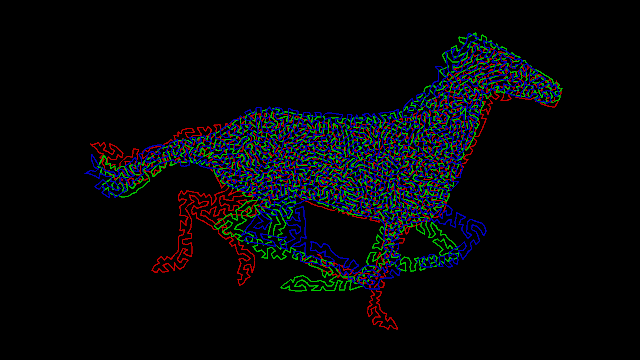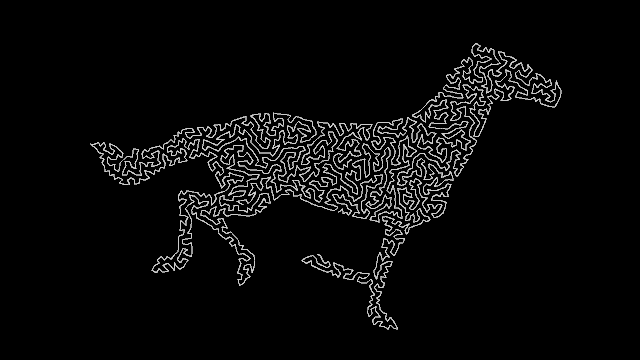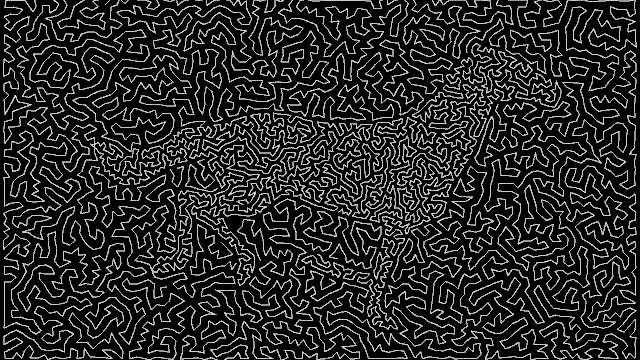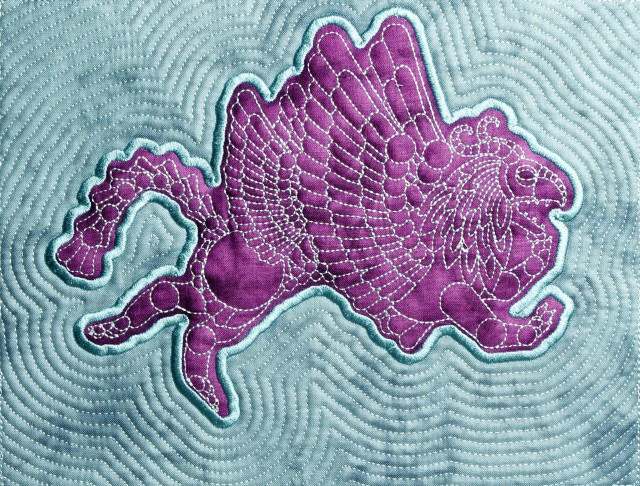CMY on K. See previous two posts on TSP animation for context: 1, 2.
 RGB on K.
RGB on K.
Animator. Director. Artist. Scapegoat.
I ran an inversion on yesterday’s horse Traveling Salesman Problem animation:
Again I had to take out a few stray lines manually. Here’s the same white on black:
 Yesterday’s negative image and today’s positive image together:
Yesterday’s negative image and today’s positive image together:
 The positive image has only 2,000 points, so it was faster to process. It’s still denser than the negative image (background) which has just under 4,000 points but covers a lot more area.
The positive image has only 2,000 points, so it was faster to process. It’s still denser than the negative image (background) which has just under 4,000 points but covers a lot more area.
Here are both with contrast on grey:
I traced the famous Muybridge horse in Flash, exported as a PNG series, processed each frame with the wonderful StippleGen2, opened each resulting .svg file in illustrator, copied back into Flash, removed stray lines by hand, and exported this animated .gif. The manual corrections are cheating and break up the single line I wanted, but StippleGen’s TSP optimizer left more lines crossing the body and legs of the horse than I could stand:
Theo’s going to see if Mathematica’s TSP optimizer with some additional restrictions works any better.
Remember when I pleaded for good Free vector animation software? The Tupi project just launched a Kickstarter campaign and I’m a backer.
Tupi’s strength is its simplicity; it’s great for kids and anyone new to animation. It doesn’t yet have the power I need to produce feature films, but its development is a good thing for all of us. Since it’s FLOSS (Free Libre Open Source), any innovations made in Tupi can be applied to other Free programs, and anyone who wants to customize it can. Oh, and it’s free – you can download and start playing with it right now.
Really this is Quiltimation, the result of our embroidery/quilting/trapplique techniques. Here’s a single frame without all the .gif compression 8-bit color artifacts:
 The trapplique technique was a lot of work, requiring multiple hoopings for each frame, as well as precision cutting and placing. We probably won’t do more of that. Our next project is more traditional embroidery with just one color of fabric and multiple colors of thread. Whole lotta math required to make this work, which is fortunately Theo’s department. Meanwhile I’ll stitch together these 12 frames into some sort of viable wall hanging.
The trapplique technique was a lot of work, requiring multiple hoopings for each frame, as well as precision cutting and placing. We probably won’t do more of that. Our next project is more traditional embroidery with just one color of fabric and multiple colors of thread. Whole lotta math required to make this work, which is fortunately Theo’s department. Meanwhile I’ll stitch together these 12 frames into some sort of viable wall hanging.
Someone has been emailing me saying they REALLY want to buy an original Sita Sings the Blues painting. These have been in storage since I moved from New York to Urbana IL last year, but I just excavated them and took some crappy photos (reflective glass! Wide-angle pocket camera lens!) for her to choose from. Click thumbnail for hi-res jpeg.
If anyone else wants to buy an original painting let me know: nina underscore paley at yahoo dot com. The outside dimensions of the wooden frames are about 12″ x 14.8″. They’re about $1000 each, give or take for more or less complex/competent paintings.